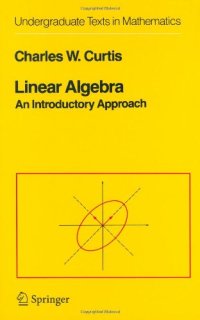
Ebook: Linear Algebra: An Introductory Approach
Author: Charles W. Curtis
- Genre: Mathematics
- Series: Undergraduate Texts in Mathematics
- Year: 1984
- Publisher: Springer
- Edition: 4th
- Language: English
- djvu
As other readers have noted, this is your standard, terse, theorem-lemma-proof type math text. If you are approaching this text with your only mathematical background being a popular treatment of the calculus like those of Stewart or Larson, the style takes a lot of getting used to. Though a lot of effort is placed into making the text short and packed with information, it is impossible to sit down with this text (or any other upper-division math text, for that matter) and read passively. Curtis leaves out many details in the proofs and examples, asking the reader to follow the ordinary, though annoying, convention of theorem-lemma-proof texts and provide the details him(yes, him)self.
In my linear algebra class, we covered the equivalent of the first six chapters, though after the determinants chapter, we stopped following the ordering and pace of the text, and therefore, it's hard to tell whether the later chapters make an optimal teaching or self-study device. The first four chapters (up to determinants), however, take a theoretical approach to linear algebra with a few scattershot references to the geometric intuitions that it formalizes.
My biggest complaint is that in some points of the text, Curtis seems unsure of whether to continue in an informal or an abstract manner. Many of the exercises are numerical problems of the type you see in a non-proof linear algebra class focused on applications, and when Curtis gets to systems of linear equations, he seems confused about whether he is writing a book for a proof-based or a numerical class. As long as you are familiar with induction and proof by contradiction, the exercises that require proofs are fairly easy. Our professor constantly supplemented them with problems that were far more difficult than anything in Curtis.
In my linear algebra class, we covered the equivalent of the first six chapters, though after the determinants chapter, we stopped following the ordering and pace of the text, and therefore, it's hard to tell whether the later chapters make an optimal teaching or self-study device. The first four chapters (up to determinants), however, take a theoretical approach to linear algebra with a few scattershot references to the geometric intuitions that it formalizes.
My biggest complaint is that in some points of the text, Curtis seems unsure of whether to continue in an informal or an abstract manner. Many of the exercises are numerical problems of the type you see in a non-proof linear algebra class focused on applications, and when Curtis gets to systems of linear equations, he seems confused about whether he is writing a book for a proof-based or a numerical class. As long as you are familiar with induction and proof by contradiction, the exercises that require proofs are fairly easy. Our professor constantly supplemented them with problems that were far more difficult than anything in Curtis.
Download the book Linear Algebra: An Introductory Approach for free or read online
Continue reading on any device:

Last viewed books
Related books
{related-news}
Comments (0)